#it's so close to be chiastic structure
Explore tagged Tumblr posts
Text
like truly two of the wildest viren-callum parallels are still, to this day
1) Viren’s re-birthday being Callum’s literal birthday because the story is just that insane about this foils bond
2) Viren and Callum both asking someone (Soren in 1x06, Rayla in 4x07) who’s sworn to protect the proposed target to kill Callum to keep things from tipping the wrong way
#the frame by frame in 4x01 too#like arc 1 was arguably about contrast (hence why viren falls & callum flies)#and arc 2 is about similarity / them switching places#callum taking more of viren's arc on (arguing with his brother-king? an unclear path?) and viren taking more of callum's arc on#(dark magic dream visions)#it's so close to be chiastic structure#aaravos being callum's metaphorical death while he's viren's salvation mmm#theme: duality#wouldn't you want to tell it kinder if you could#it was just red#tag ramble#thinking about if viren defects in S5 and if kpp'ar is in the coin like callum having#two former dark mage mentors to ward him away from repeating their mistakes but like. the Cycle goes on y'know?#edit: also honestly another point in the 'rayla will save callum' column given that soren ended up saving ezran
93 notes
·
View notes
Text
Good Omens S1 Parallels - 1/?
Saturday Morning Funtime is a particularly interesting episode for me, because it suggests something about the structure of parallels Season One. Also, it's easier to start with a single episode than trying to cover the whole show at once. I'm going to show you six different scenes from Saturday Morning Funtime and how they link together.
Let's start with the pun pointed out by Danny Motta in his video (link here to relevant timestamp if you haven't seen it). Danny made the link between this scene near the start of E4, where Aziraphale gets exercise:

And this scene at the end, where Aziraphale was exorcised (according to Shadwell, at least):

Cool, seems like a funny pun. But there's no way to know it was intentional right? Well, I think I can argue it was. Let's look at another scene.
We have this scene where Hastur destroys 3 Erics on the plains of Megiddo. Since each demon has a corresponding animal, I'm going to go ahead and place bets on the Eric's being rabbits, and Hastur destroys 2/3 of them.
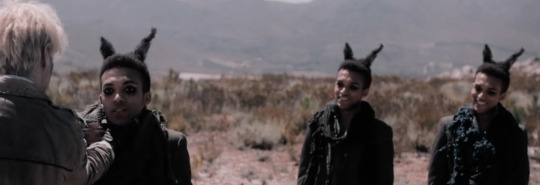
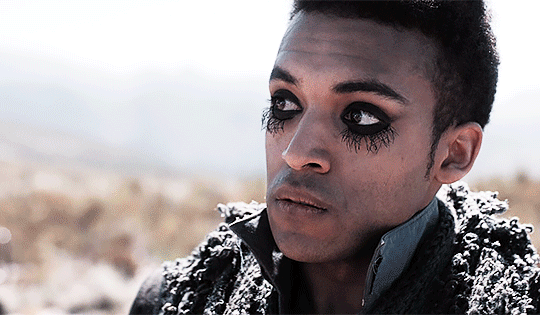
And then later we have this scene where Hastur again destroys 2/3 rabbits, but this time they're cartoon bunnies - the first one he beheads like a costume, the second he rips out it's throat.
youtube
Ok, but again, why am I linking these two scenes? No deep character insights, or thematic elements are being displayed here... Except that's a key reason I'm pointing them out - they're seemingly pretty pointless, so why bother to make them? Well, maybe the sum is bigger than the parts. One more example and then I'll show you how this comes together.
Here's a scene which I think is pretty good foreshadowing of something that will happen later in the episode - Hastur and Ligur talking about the dripping pipes down in Hell. Hastur has a little bucket he's collecting water in, which he uses in a toast:

And later, we have this particularly gruesome scene of Ligur becoming toast at the hands of a bucket full of (holy)water:
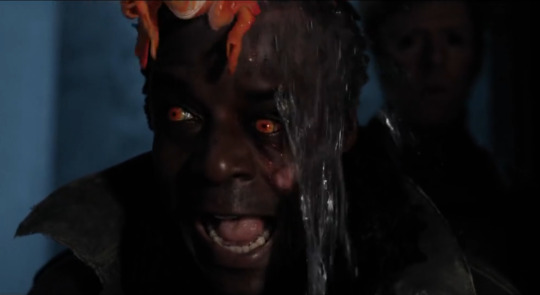
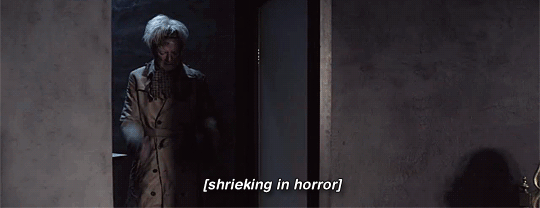
Ok, so six scenes, three sets of parallels... now's where the magic happens... I take E4 as a whole... loop it over on itself like a piece of trick rope from Goldstein's magic shop and....
Tada! Here's the episode laid out in 2 minute increments.

Some pretty interesting places to have parallels, no? That two minute block at the start is a lead in before the opening credits, so the Exercise and Exorcism scenes are coming directly before and directly after the open and close sequence (shown above in blue).
I'd be lying if I said it didn't remind me of the overall chiastic structure that some people have worked on, such as this one by @drconstellation, just on a smaller scale.
It's also interesting to note that each of these parallel pairs relates to someone getting discorporated - Eric, Ligur and then Aziraphale.
What's the point?
So, I promised that I would share a little on why this might be important. In my opinion? It appears like there is some detailed structure to Good Omens, at least in S1.
It should also be noted that these scenes were added only for the show in order to produce this effect - Aziraphale exercising with Gabriel, Hastur and Ligur talking about the pipes, the three cartoon rabbits in the theatre - they were all newly created for the show.
Why go to the bother of creating these little parallel moments at corresponding points along a mirrored structure? Especially when these don't necessarily have ramifications for characters or plot? Is it just good story telling or is it something more? These are all questions worth asking in my opinion. I think it relates to how this show treats words and language in a very Pratchetty fashion. The whole show is a dedication to Terry, after all.
Of course, if things were so simple, I think we would have figured it all out long ago. Parallels, puns, wordplay... they're all quite slippery things. There are things I would consider to be parallels which don't line up with this same structure. For example, the scene from earlier with Gabriel and Aziraphale exercising? The "lose the gut" gut-punch foreshadows this other gut punch scene in E4 too:


Despite examples to the contrary, the presence of parallels and wordplay that do line up along a mirrored structure makes me want to explore this further. If you're also interested in this and want to collaborate, please let me know.
This will be a continuing series, as and when time allows, because parallels seem to be absolutely everywhere. Future posts will look at parallels at different levels (within scenes, across episodes, and across seasons).
Let me know if you spot any others - I'd love to hear about them. They might be hidden in the visuals, wordplay, puns and more...
----------------------
With thanks to all the detectives for keeping me clue hunting @embracing-the-ineffable, @theastrophysicistnextdoor, @noneorother, @somehow-a-human, @komorezuki, @maufungi, @lookingatacupoftea, @havemyheartaziraphale, @251-dmr, @dunkthebiscuit, and @ghstptats <3
#Youtube#good omens#good omens meta#terry pratchett#good omens parallels#good omens theories#good omens analysis#good omen details
139 notes
·
View notes
Text
Chiastic Structure of S1
Here it is!
Yes, I deliberately made it detailed. You NEED to see the detail, it is, quite frankly, eye-opening in parts.
If the image I have posted is not clear, let me know, and I'll post a broken-down version in sections so you can read it. I'm just not sure how this is going to work.
I've got five footnotes for various sections where I want to make extra comments, so see them below.
If you don't know why some of us are looking into this - a chiastic structure or pattern a literary device where a sequence of events is presented then repeated in reverse order. For a complicated story like Good Omens this can and does gives us some interesting insights into the hidden stories we meta writers like to speculate on and discuss.
I have to admit it got a bit messy in places, so there still might be some tweaking to do in the middle parts.
The plain parallels still exist - I have a couple to mention in the footnotes. I'm also very excited about taking this challenge on because I've basically found proof that backs up my theory about the scene at Tadfield Manor telling part of the story of the Great War in Heaven, and also proof that the Flood may have been the time of their first "vavoom."
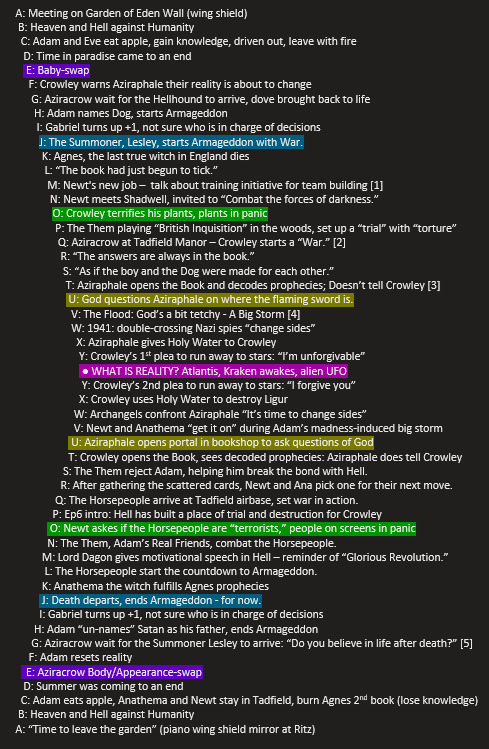
[1] M-pair: When Newt turns up to his new job there is an office meeting called and the upcoming "training initiative" is discussed. This then leads on to the paintball fight at Tadfield Manor. I discussed how the two scenes give us an insight into the past and the Great War in two metas, The Great War of Tadfield Manor, and The Newton/Crowley Mirror-Parallel in S1. The mirror-pair here is Dagon is rousing the troops with reminders of the "Glorious Revolution," providing us with a direct connection to the events of Tadfield Manor.
[2] Q-pair: This is a really interesting pair, as as it is still tied in with Tadfield Manor. Does it give us any insights into Crowley's role in the Great War and his Fall? I'll be looking more closely at this in the future!
[3] There is an interesting set of parallels around this area that didn't quite fit into the chiastic structure proper that I though was worth mentioning and I have already flagged for a meta before I had finished plotting this out. It's to do with Newt and Anathema and the prophecies in the book - oh, and the Velvet underground reference. Actually, I really need more space for that...you'll have to wait for the meta, sorry.
[4] Ohhh yeah. This one. The Vavoom moment. I wondered if the sex under the bed between Newt and Anathema would reveal anything. It certainly did! If you haven't read @vidavalor's meta about the first time they probably kissed, then you should. Stat! This pair backs it up - and maybe more.
[5] There is a parallel noted here that doesn't fit in the structure, that Crowley signs to start everything rolling, and Aziraphale signs to end it.
On to S2. Then I'll see if I can work a three-series structure together for some predictions.
Link to S2 Chiastic Structure Post.
@aprilodite @kayleefansposts @ineffable-endearments @sendarya
170 notes
·
View notes
Text
Good Omens Season 2 Chiastic structure
Inspired by @drconstellation I am working on a chiastic structure for the second season.
I'm not done yet, but there are already some things I've noticed.
When Gabriel first arrives and says, "You're funny, I love you," Aziraphale stops himself from saying "I love you" back -- because he doesn't, and it's not a secret that he doesn't. In the Final Fifteen, after the Big Damn Kiss, Aziraphale also stops himself from saying "I love you," but this time because he DOES, but it is a secret that he does.
Directly mirroring Gabriel bringing something to Aziraphale so something terrible doesn't happen to him (but he forgets) is Crowley giving something to Aziraphale so something terrible doesn't happen to him, Aziraphale. There's been a lot of speculation as to what Crowley could have passed to Aziraphale, and I thought it was the fly and now I'm sure. Gabriel fails to give Aziraphale the fly and whatever is in it, Crowley succeeds.
The middle point is Shax confronting Crowley about Gabriel being in the book shop, and then confronting Aziraphale about Gabriel being in the book shop. Okay, Shax Closes In is the middlest bit -- what does that mean? If we assume that Crowley and Aziraphale are hiding something besides Gabriel, we get two tidbits: That Shax is looking for something besides Gabriel, as evidenced by her question to Crowley on the bench at St. James park -- got anything for me? And she asks about Crowley sharing anything he gets from his contact in the book shop. Whatever she's after, it's something Heaven and an angel would know about. Jesus, perhaps? Gabriel is a side-mission for her. She's after Jesus, and Crowley and Aziraphale are hiding her. The middlest bit is Shax Getting Too Close.
I'll be sure to post the finished chiastic structure once I have it all figured out!
#good omens#good omens 2#crowley#aziraphale#good omens meta#ineffable husbands#good omens analysis#good omens fan theory#ineffable mystery#chiastic structure#chiastic structure of good omens 2
51 notes
·
View notes
Text
The Second Coming...of Agnes Nutter?
Come with me, and you’ll be In a world of GO speculation…

This is a meta-flavored GO Season 3 speculation post. Not to sound overconfident - I’m no Agnes, and these stray thoughts are decidedly not reminiscent of Nostradamus at his best - but DO NOT TAG NEIL, please and thank you kindly.
I’m rewatching season one, and couldn’t help but notice some interesting details about the depiction of Agnes Nutter and her death in S1E2. While a common line of speculation is that Jesus’ Second Coming in S3 will somehow mirror Adam Young’s story as the Antichrist, there are enough potential parallels, mirroring, and inversions in elements of Agnes’ story that I’m now wondering if we should instead be looking to her for clues about what Season 3 will hold.
I’ll also note that, unlike many wonderful meta authors on this site, my knowledge of Christian theology is limited to what I’ve picked up culturally. That said, I beg the reader’s forgiveness in advance for any errors or mischaracterizations in the commentary below.
@aprilodite and others have written about a possible chiastic story structure at work in S2, and potentially over both S1 and S2. So as I run though these points, I’m also looking for things that might have mirrors over the course of S3.
The S1E2 ‘flashback’ to 1656 ends with Agnes’ daughter Virtue and her husband John receiving their bequest: a box (later revealed to Anathema and Newt to contain the second book of prophecy) and a book (The Nice and Accurate Prophecies themselves). Working backwards within a presumed chiastic storytelling structure, we could have already been introduced to the mirrors of these items over the course of S2. There are two candidates for the box: the first, obviously, is Jimbriel’s box, which may or may not have been heavier when he started carrying it than when it arrived at the bookshop containing nothing but a fly. The other candidate might be Aziraphale’s briefcase, contents unknown, which he appears to leave behind to Edinburgh in S2E3. And of course, S2 introduces us to the Book of Life, which seems to contain information pertaining to the past (possibly names, or memories, or events relating to beings’ having never existed), mirroring Agnes’ book of obscure knowledge about the future.
Agnes is accused of witchcraft partly as a consequence of helping her neighbors (curing their poxes, dispensing health advice, and so forth). Watching the crucifixion in S1E3, Crowley notes that execution is a characteristically human reaction to Jesus’ injunction: “Be kind to each other.”
Like the Biblical Jesus, Agnes knows about her death in advance and goes to meet it willingly. In doing so:
She brings death-by-explosion-and-roofing-nails to those around her (inverting a promise of eternal life).
She uses her execution as a teachable moment: “And let my death be a message to the world. Come. Come, gather thee close I say, and mark ye well the fate of those who meddle with such as they do not understand.” Her words can be read as: in killing me, you meddle with the ineffable, and in so doing you doom yourselves. This could be a potential mirror to, or inversion of, something a returned Jesus might say in S3: you (humanity) killed me, thus meddling with the ineffable (or doing what She had planned all along?), but you have been forgiven.
#good omens#good omens speculation#good omens season 3 speculation#good omens meta#good omens 2#good omens 1#agnes nutter#the second coming#crowley#aziraphale#chiastic structure#good omens analysis#adam young
52 notes
·
View notes
Note
If you have the spoons to watch it, I think you’d really enjoy this retrospective about Mob Psycho 100.
https://youtu.be/kfxhrOYAXqs
It’s like an hour long by Mother’s Basement, but it’s really good and goes over the themes and ideas of the series.
Thank you!! I finally had the energy to watch this the other day and I really enjoyed it! (I also really like the videos he did about the S1 and S2 openings, which were really interesting to me as someone who knows very little about animation!) I especially liked some of the stuff he talked about with Claw, like going into more depth about the proverb their name comes from and how Touichirou is wildly misinterpreting it.
Also. I want that man's Dimple shirt.
However! I was really excited to hear his thoughts on the structure of the show (at the beginning of that segment when he talked about it having a "chiastic ring structure" I gasped aloud in delight because I am a predictable nerd), but I feel like that's one thing I disagree with him on. Conceptually he's right, but his actual breakdown of the arcs and structures suffers because he needed to create something that would make a nice graphic (thus ignoring or glossing over a lot of complexity), he incorporates various flashbacks into "arc 1" instead of actually engaging with the structure of the show as written, and also he, like many people, doesn't seem to understand the importance of the aliens arc (it's not even mentioned in his structure graphic!! A failing!). The structure talk/graphic starts at about 20:37 in the video if you want to see what I'm talking about.
I might make a proper post on it at some point but my very basic thoughts on the chiastic structure are:
Club Recruitment (I don't think we have a name for this one specifically bc it's only one episode but it sets up Literally The Entire Show so) mirrors Aliens/Telepathy Arc
Lol Cult and Black Vinegar mirror Divine Tree
Big Cleanup and 7th Division mirror World Domination (Big Cleanup is a little messy and I feel like fits less neatly into this than most other arcs; parts of it are more closely tied to Divine Tree's themes of getting carried away, but the Ritsu and Shou plot during World Domination is very much in dialogue with Ritsu's Big Cleanup plot)
And the middle of the ring is the back-to-back mirrors of Mogami Arc and Separation Arc
Now, Confession is specifically outside of the ring composition; it's a synthesis of a bunch of important themes and character arcs that it revisits in order to provide resolution. Tbh it deserves a structural breakdown of its own; it has so much going on and it's SO GOOD.
Also obviously there is a lot more going on than the ring structure because the themes are very consistent and the parallels are EVERYWHERE; I have yelled at length about the Mogami/Divine Tree parallels and tbh you could probably do the same with any combo of arcs. But I Just Think Chiasmus Is Neat.
52 notes
·
View notes
Note
Can I ask you #15 right back? Because I'm always so impressed with how you are forever learning.
You are so sweet, along with all the wonderful humanz who have given so generously to the project of shifting lil baby turanga towards current toddler stage.
Ask game here.
I honestly had no idea, when I started writing fan fic in March, how much, exactly, I was going to learn this year. I, like, actually studied writing at a prestigious four-year university back in the day: I thought I knew things, I thought I had tools. I quickly realized that I knew almost NOTHING about plotting or point of view, and then I banged my head for months against dialogue and tense. And this is to say nothing about things like epigraphs epifauna epithets or Hellz Yeah Chiastic Structure.
But the thing that I actually learned, reading and writing Harry Potter fan fiction while navigating some of the life shit that led me to go "hey, I wonder if stories about fictitious wizards would work as Trauma Therapy," participating in Hell Competition and finding, refining, and using my voice...is weirder, harder won, and more precious than any achievements in learning how to write. I learned that I actually am, for better or for worse, a Gryffindor, a person who holds courage close and will choose it on purpose regardless of their fears. I discovered, through the Sorting Hat Chats quiz, three basic words that encapsulate a lot that has driven me for years without me even having the language for it: "steadfast intuitive morality." And, in big ways and small ways, ways that made sense and ways that were to all observers including me utterly fucking ridiculous, I learned about what it looks like--for characters, for real people, for ME--when people take actions that line up with their beliefs, and see those actions through to the places beyond their immediate consequences.
In reading the stories of others, in telling my own stories about people who aren't real, I came to better understand my own different narratives. It's been a wild ride, and it's been so very worthwhile.
2 notes
·
View notes
Note
Hey could you do your top 5 Durarararararara characters?
Before I start I want to say that my faves are not trash, and I do not have trash taste. In fact my faves are incredibly sexy and I have amazing taste in people. I feel no shame at all for liking the characters that I like. Anyway, here’s my list of favorite Durarara!! characters that’s Izaya, Izaya, Izaya, Izaya’s best friend, and Izaya’s employee. You can’t shame me because I physically lack the ability to feel shame. I love my faves and I love my taste in characters.
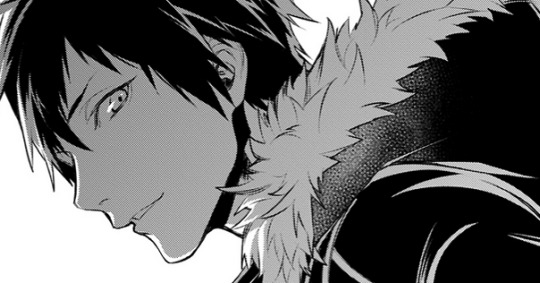
1. Orihara Izaya - What I love about Durarara! as a series is it doesn’t feel the need to moralize the characters. Every character present is flawed, some more than others, and instead of trying to sort them into good or bad people the series is way more interested in just exploring them as characters, their interactions with others, and all of their various flaws. It lets them be people first before anything else.
Izaya is my favorite character not because I think he’s a cool mastermind who always is in control of things, and always sees through people, but rather because he’s nothing like that. Izaya is not the villain he desperately wants to be or for other people to see him as. Izaya at the center of his being is a very fragile and delicate person. He’s sensitive, and he knows that his sensitivity especially towards the feelings of others is going to break him badly if he ever tries to form any real relationships, so he just doesn’t. He loves humanity as a whole, because loving any one person would be too much for him.
I like Izaya because he’s a kid playing games. He’s so desperately out of his league, but just clever enough that he tends to keep people hoodwinked. Underneath it all he’s just kind of a petty person, but the ways in which he is petty are so complex and fasicnating. The way I’ve always read the Izaya and Shizuo foiling is that Izaya has always been more sensitive and aware of other people’s feelings than Shizuo in a way that would actually hurt him, whereas Shizuo is pretty dense to people’s feelings over all. That’s why they want opposite things, Shizuo wants to be closer to people, and Izaya wants to run away from them.
Izaya’s at his best when he’s convinced that he’s the one forcing everybody else to play his game, only for the world to smack him in the face and show him that he’s just another player in the game like everyone else. He’s incredibly small scale and petty, but because of that he feels more human than most villains. He’s not even that much of a villain in the end, just kind of annoying over all.

2. Kuronuma Aoba - Izaya Ripoff #1. Some people can’t bring themselves to like Aoba because he’s not as good as Izaya, but that’s always read like the point to me. Thematically I think the entire second half of Durarara is supposed to read like a lesser and cheaper rehash of the first. (That kind of mirroring is something Ryohga Narita does in the structure of his stories a lot, it’s called Chiastic structure technically). Well anyway I love him, and my taste is awesome.
Aoba’s response to Izaya is that he met Izaya once and noticing their similiarities decided to develop into Izaya’s opposite mainly out of spite for him. Izaya loves humans, and Aoba hates them, but for both of them they need to be at a certain distance from other people in order to function. They both fundamentally can’t get close to others, Izaya because he’s a little too smart for his own good, and Aoba because he’s a victim of trauma, but also an active one who needs to take absolute control of everything including his trauma.
Aoba is interesting because he has this longing and desire to be human (we see the reverse in Kuon.) He will spend time with the Orihara Sisters specifically because as a way to remind himself he’s still human and capable of making connections with people. Aoba gets genuinely touched when Mikado shows him the most mundane concerns like bandaging his hand and offering to help with his summer homework, because Aoba’s never really been a part of the normal everyday life that Mikado just has naturally. He’s always been rebelling against someone, either his brother’s abuse, his parents who let that abuse happen, etc. etc. He’s only ever realy engaged with other people through his crafted fake persona that would smile during the daytime and be liked by his classmates and then go home to be beaten by his brother. Those moments of genuine feeling really get to Izaya, because unlike Izaya whose content to be fake and keep playing games Aoba is chasing after the real thing.
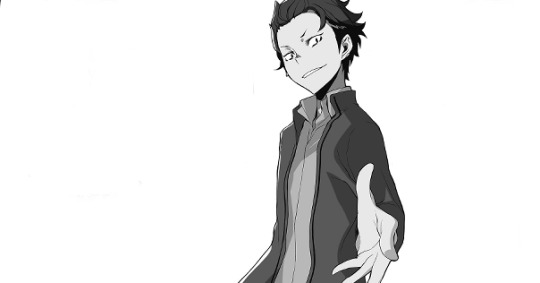
3. Kotonami Kuon - Izaya ripoff number two! No regrets! I like Kuon and Aoba so much because writing wise they read as very interesting responses and remixes to Izaya for me. I like that kind of thing, foiling, mirroring and the like.
Aoba wants to become genuine but he’s a little too good at controlling people, and a little too smart to fully surrender himself to the normal everyday life he wants so badly. Kuon’s the exact opposite, he desperately wants to become a fake like Izaya, but he’s way too human, cares about his connections with other people too much to go all the way. Kuon wants to be Izaya but he sucks at being Izaya, which is ironically why he can have friends in the first place.
There’s a special subtrope of bastard characters that I like called Wannabe Bastards. That is they’re kind of too incompetent to truly ever be the mastermind they see themselves as. Izaya is definitely already a bit of a wannabe, so that makes Kuon the Wannabe of a Wannabe. So what I like about Kuon is how genuinely weak he is, but also how motivated he is in spite of that weakness.
He’s a character you get to watch continually fighting against his own weakness in the story. He’s such an underdog you almost want to root for him, even though he’s usually the cause of his own, and everyone else’s problems. He’s motivated by very strong and genuine sentiments that neither Aoba, nor Izaya have because they’re both kind of too delicate to feel strongly about anything. He’s also very self aware of how low and petty of a person he is. It’s interesting to watch him throw himself into his pretend-Izaya act already knowing he’s not good enough to be Izaya, and trying to make up for the difference in effort alone.

4. Kishitani Shinra - Shinra Kishitani is a terrible heterosexual. He’s a character that would have been annoying in any other author’s hands, beucase Shinra kind of refuses to grow. He’s so codependent that the moment his roommate shows any small inclination that she might leave him, he’ll immediately resort to lying, cheating, and doing anything he can to control her.
What saves Shinra’s character is a lot of self-awareness on Shinra’s part, and also how frank the story is about his flaws. Shinra is genuinely detached from people in a way Izaya wishes he could be. He plays nice with people, and thinks it’s good to have friends, but really Shinra can just shut off his feelings and stop caring about another person or what happens to them the moment they become an inconvenience to what he wants. Even the person he loves the most he has a hard time seeing as a person separate from himself, with wants and needs that are separate from his. Shinra calls himself a villain in love and he might have better claim to the title of villain than Izaya. The only reason Shinra doesn’t go out of his way to hurt people is because he’s relatively benign, if they don’t interfere with him and Celty then he doesn’t have a reason to care about most people.
Shinra is excellent because his foiling and relationship with Izaya is one of the most compelling in the manga, due to how much they both call out each other’s flaws. They’re really the only people that they can genuinely feel attachment to like as people, but that’s also why they can’t stand to be around each other. They’re best friends but also at a distance, kind of more like pen pals. Shinra and Izaya both have big gaping holes in their hearts, and they both want to pour their love into something, Shinra just pours it all into one person, whereas Izaya loves all of humanity.

5. Yagiri Namie- Once again I like Namie because she’s a parallel to Izaya, surprise, surprise. Ignoring the weird parts of her character (because Narita just has to be weird sometimes) I think there’s actually a lot of intersting ideas at play with Namie. She’s someone who claims to live for the sake of love, but she’s just kind of cold and cut off from absolutely everybody.
Namie was smart enough to realize that her parents had no affection for her and her uncle was only in her life to use her, so she kind of just decided on her own to treat her brother as her only real family. Namie’s just kind of using Seiji the same way that Mika does. Obsessing over Seiji is just kind of an excuse to deny herself the pain of having to actually try to form connections with people.
Namie loves Seiji but she really kind of doesn’t. The two of them don’t even have that great of a relationship, Namie steps over Seiji’s boundaries, and Seiji just kind of ignores her and only pays attention to her when he explicitly needs something from her. Seiji just uses Namie like the rest of her family, but Namie’s fine with that because she’s using Seiji to. Seiji is just kind of an excuse for Namie to deny herself love. Because love is something she’s never had and it’s something that would most certainly hurt her. Both Mika and Namie are choosing to obsess over someone who isn’t really capable of loving them back (and I mean in a familial way in Seiji’s case he’s just kind of annoyed by Namie). And that’s the point. They don’t want to be loved. They don’t want to deal with other people’s feelings. It’s ultimately all about them.
Which is also the foiling to Izaya, both Izaya and Namie are incapable of loving because of the pain involved so they just seek out subsitutes to obsess over instead. They see themselves in each other, and because of that they’re constantly cutting at each other, and yet somehow cozy up to each other in this weird mutually trusting relationship. They’re both really cold people and they can get along because they’re used to freezing.
151 notes
·
View notes
Text
Resurrection Community: Family-like Love
1 PETER 3:8
There are things our bodies are wired to do in the face of threat. We hone in on survival-relevant information and slip into a better-safe-than-sorry mode of being. This mode comes with a small range of options: attack, run away, vomit, pretend you’re dead etc. Those things serve a purpose but they’re not the full palette of life. Doped up on cortisol (our natural stress hormone) over the long haul we become sick. It’s exhausting and unhealthy, in a slow-release kind of way.
That’s the kind of embodied reality facing the folk that Peter is writing to in their embattled, outsider-status communities. We’re in a different boat with this Covid-19 situation but from a physiological perspective you might notice your threat-detection system is activated more than you are used to during this time. A person sneezes as you pass in a supermarket aisle. You flinch and feel the flush of anxiety. You pass through the aisles that bit quicker and worry about accidentally touching your face before you splash sanitiser all over you. You’re at home and the walls start to feel like they’re closing in. You’re irritable. Snappy. Tired. You’re eating too much. Can’t relax. That’s your body in basic survival mode.
Fortunately, it’s not the only mode. We have another system that soothes us basically, helps the warning sirens and flashing lights to calm down. We become disarmed, open, and peaceful. One of the best ways to bring this soothing system online is through affection and kindness. A smile. A caring, understanding face looking back at you. A hug. A compassionate tone of voice. We feel safe, valued, and wanted. Love has a huge say on the human experience. We are designed to thrive on kindness and compassion.
So maybe we’re not in the same situation as those Peter is writing to, but we still have the same needs and there’s cross-over. Peter here is writing to help people to know what kind of community we need to be for each other when we’re going through more than enough already. In our own church communities this is exactly the kind of matter we need to pay attention as we navigate life in a global pandemic. Things are tough, we feel strain as it is, what can we be for each other?
Peter offers five invitations for embattled communities to live into within their shared life together:
“all of you, have unity of spirit, sympathy, love for one another, a tender heart, and a humble mind.” (NRSV)
Scholars and interpreters sometimes talk about a thing called a chiastic structure where the biblical authors write in a certain way to make their big points. They sandwich their take-home message in between some other paired statements. If we read verse 8 in this way we would come up with this:
1a. Have a unity of spirit
2a. Have sympathy
The core bit: Embrace family-like love
2b. Have a tender heart
1b. Have a humble mind
In other words, the heart of what Peter would be urging here is for Christian community to shaped by genuine love for each other and all the other parts relate to that central theme in some way. I’m going to use this kind of way of reading the text to try and understand what Peter is saying here.
So to begin with, Peter’s Big Picture vision for Christian community: a community defined by love.
Peter uses the Greek work “philadelphoi.” You might have the American city Philadelphia pop you’re your mind, ���The City of Brotherly Love.” That is literally what this Greek term means. It refers to brotherly love. Sibling relationships. Loving each other like family. Family doesn’t always behave like this but when we talk about family love we infer deep commitment and belonging, the sense of being bound together with bonds of mutual affection. Peter is saying Christian community should be the type of community where everyone has each other’s backs; the type of community that doesn’t walk away from each other when the going gets tough.
And things are tough. Peter is writing to folk who are on the outside of the society they inhabit. But not in the church. In these communities you experience family. Brotherhood. Sisterhood. Solidarity. Connectedness. You belong here and you can’t just be squeezed out. And of course, from a Big Picture perspective, this is the truth of our common experience. If I am a child of God, and so are you, we are siblings. We are bound together in love. The trick is living into that reality! This is invitation before all churches. This is the place where we practice “brothering” and “sistering”
But how do we really live into this reality?
How is it that we become a family where all belong, with an unbreakable sense of commitment?
How can we become the kind of community where we properly experience having a group of people in our corner?
If we take this notion of family-love to be the heart of Peter’s message then the other invitations fit within this bigger vision. In other words, we build a community defined by family-like love through cultivating a sense of unity of spirit and humility and through having sympathy and tender-heartedness. This will be explored over the next couple of posts. But before we do, do a body scan right where you are. Work your way from your toes to your head. Do you find tension? Is there stress or anxiety trapped in your body? Have you experienced kindness and affection this day? Could someone be this for you on this day? Could you be this for someone else? We are built for this kind of connection. Have love for one another.
1 note
·
View note
Text
Re: The Hero’s Journey
Lately, and maybe for a lot longer than lately, I’ve been stuck somewhere between outlining the scenes I want and agonizing over story structure. Three Acts or Four Acts or the rare and oft-misinterpreted Freytag’s pyramid. MICE Quotient and Nesting Codes** and Save the Cat (ugh) and Dan Harmon’s Story Circle. The thousand half-assed systems invented by the thousand of mediocre fiction bloggers* more interested in SEO and selling ebooks* about writing than writing itself. And, of course, the goddamn Hero’s Journey.
It’s enough to make your head spin, but if you look close enough? They’re all the same* and they all tell you, dear reader, that “YOU ARE DOING IT WRONG!” If you don’t have a pinch point at a certain percentage of the way through, what are you even doing with your life? Can you even read??
tl;dr: https://writerunboxed.com/2013/06/13/why-the-heros-journey-is-a-tourist-trap/ If you’re stuck in the writing advice echo chamber that is the same theory dressed in different ways, I hope you’ll read the link above.
*FUN FACT 1: The internet will gaslight you and not all advice is good and I forget that a lot sometimes too and get convinced I’ve fucked my story because I’m a pantser and I didn’t do that Snowflake Method thing that is the ~checks notes~ KEY FORMULA TO SELLING A NOVEL/NUMBER ONE EASY WAY TO WRITE A NOVEL/BEST 6 STEPS FOR A POWERFUL STORY OUTLINE.
it’s fucking horseshit yall.
**FUN FACT 2: Mary Robinette Kowal’s nesting code approach is a repackaging of basic chiastic structure used all the way back in the freaking bible, no matter how many bloggers slap on buzz words like information architecture. No knock on Mary - I love hearing her talk about writing and stories and Writing Excuses is one of my favorite things.
But the whole structure thing has been bothering me a lot and sending me down gaslit rabbit holes and my engine is stalling because according to every reference I find, I’m doing it all wrong anyway and Save the Cat (ugh) and at least 720 other bloggers want you to know that you’re protagonist must feel total despair at the 82% mark of your novel
It’s not working for me and hasn’t been working for me and then today I found this:
https://writerunboxed.com/2013/06/13/why-the-heros-journey-is-a-tourist-trap/
I’d already perused a lot of her other advice that actually sounds a lot like what I know to work on the copywriting side of the ocean. Writing for the sake of sounding flowery gets in the way of the story. Your writing is about finding emotion, not proving you know the definition of a plot. That likable characters and relatable characters are VERY different things.
And I needed to read this so badly today. Because I *know* I can write whatever story I want to write and I’ve read so many that don’t fit any of the stupid structure molds and frameworks and templates you are told you should use. But when you’re stuck and you need inspiration and the internet floods you with authorities-that-are-not authorities all screaming the same theories in whatever words Google prioritized in the particular year it was written, it’s a lot to drown out.
If you’re like me, I hope it helps you too.
1 note
·
View note
Text
No One’s Ever Really Gone: The Synergy of Narrative and Poetic Structures in the Star Wars Sequel Trilogy
IMPORTANT: The following essay will draw upon existing work for a lot of its content and conclusions. I do not claim credit for the work cited to others below, though my interpretations and commentary are included throughout. Most of the content I’m referring to can be found in links included below, and the primary sources are @ohtze‘s “Kill the King and Take His Crown,” and @ashesforfoxes‘ “The Descent.”
You can also find a lot of really insightful work on this stuff by listening to related podcasts, like recent episodes of SW Connection, Metamashina and Scavenger’s Hoard. Literary theory isn’t new stuff, and any analysis will necessarily stand on the shoulders of giants. However, I hadn’t seen any analysis on the synergy and interplay of the various tropes and archetypes discussed.
TO BE PERFECTLY CLEAR: The summary of the constituent parts of these tropes and archetypes is based on the work of others, in both written and commentary form. My contribution is the assignment of the various elements to the heroic, character, and narrative structures, and a guess as to how those elements will play out on screen. Some of the guesses are close to or identical to those suggested by Ohtze, because I think she’s right, but I’ve added editorial commentary and my own spin on it. The summary of the literary structures is intended as crib notes for anyone unfamiliar with these terms or other works.
So, if you’re ready, join me below the cut. [I’ve tried about seven times to add the cut so it’ll show on mobile, and it won’t for me, so idk]
I wrote this meta about six weeks ago, and have put off posting it here for a number of reasons. But, having looked it over, I feel fairly sanguine about it. I’ll probably add pictures/gifs later, but for now, I’m not going to bother. Strap in, though. This is a hell of a ride.
My lit theory engines have been running non-stop since The Last Jedi was released, because I could see there was a highly developed structure underpinning everything. I just couldn’t put my finger on it, and, while some tropes and archetypes I’ve encountered as applied by analyses in the fandom fit in certain areas, others didn’t match up. But now I think I see what’s being done, and, well, goddamn.
What we’re seeing here is the synergy of the entire saga being brought together. J.J. Abrams himself said Episode IX is intended to do just that. The question is: how do you accomplish that? Through the evolution of the saga, different through lines have been adopted and integrated. First, there was the mythic, then, the tragic, followed by the poetic, and, finally, the gothic. Now that there are four distinct and synergized elements guiding four distinct elements of the saga’s conclusion, finding one pure parallel is nigh impossible, and for good reason: this is more ambitious than anything a major production has really tried.
As my professional training is in the law, it wouldn’t do to structure this as I would a creative work of fiction. So, in deference to the legal tradition, here’s a summary of conclusions:
Star Wars operates first and foremost as a Hero’s Journey, or, more specifically, three separate journeys: The Hero’s Journey of Luke Skywalker, the Tragedy of Anakin Skywalker, and the Heroine’s Journey of Rey of Jakku. These three journeys are distinct and operate within an overall poetic structure that binds the saga together. Each trilogy represents a poetic stanza, and the three trilogies are arranged overall as a palistrophe (wherein the tragedy of the first stanza is unwound and reversed by the third).
[In earlier versions of this essay, I incorrectly identified the poetic device being used here as palindrome. Credit to a Facebook user to calling me on my bullshit and not letting me talk my way around it. The device I intended to identify is a chiasmus, and more specifically, a palistrophe, in which chiastic structure is used to address broad elements, rather than exact mirrors. A palindrome is far too constrained a device for it to be the appropriate device, and I ought to have known it. A good example of a palistrophe is the Biblical story of the Flood, in which the first act details the coming of the Flood, the middle act deals with the consequences of the Flood, and the third act unwinds and reverses the first and presents the elements as mirrors, thus arriving at different thematic conclusions.]
The Original Trilogy features monomythic character archetypes and narrative, needing nothing else. The Prequel Trilogy features tragic character archetypes and narrative, utilizing a failed Hero’s Journey as its mythic foundation. The Sequel Trilogy features the same tragic character archetypes as the Prequel Trilogy, but inverts the roles and elements as befitting the palistrophic poetic arc, and, as the gender roles are reversed, employs a Heroine’s Journey to counteract the tragic conclusions of the Prequel Trilogy. Because neither the monomythic nor the tragic narratives are applicable to a non-tragic Heroine’s Journey, the Sequel Trilogy adopts a gothic romantic narrative to carry the poetic and heroic arcs to the Heroine’s Journey’s conclusion.
In the applications of these various tropes, the Sequel Trilogy uses the base narrative of the gothic romance, but those elements that do not comport with the tragic character archetypes are overridden by the archetypal dicta. Similarly, because the Heroine of the Sequel Trilogy does not have a tragic flaw, when the conclusions reached by the tragic archetypes or the gothic narrative would conflict with the requirements of the Heroine’s Journey, those conclusions must be controlled by the Heroine’s Journey.
Here follows the more specific discussion. Let’s follow the bouncing ball:
The Original Trilogy was powered by a simple Hero’s Journey: Luke Skywalker’s. The classic Campbellian monomyth is applied in almost perfect step-by-step progression. Taken on its own, this is all that’s needed. George Lucas took the pulp elements of space opera and placed his Hero on his journey through it.
But then Lucas decided to make the prequels, and he wanted to use the same mythical structure, but the archetypes of the monomyth didn’t work. Why? Because Anakin Skywalker is not a classic heroic figure. He is a tragic hero; that is, the Hero of the monomyth, but with a fatal flaw that prevents him from completing his journey. To do this kind of story, Lucas elected to draw from Sophocles himself and took the base archetypes from Oedipus Rex (the greatest of all Greek tragedies), applied them to the Star Wars universe through the Hero’s Journey, and we saw that play out exactly as one would expect it.
In Ohtze’s excellent meta, “Kill the King, and Take His Crown,” she details the application of the Usurper/Holy Mother trope as established by Greek tragic tradition (and supplemented by Freudian analysis), and I’ll be discussing that here. The trope, by my reckoning, applies mostly to the characters moving within other structures, but applies very broadly to the Prequel Trilogy by dint of being a straight transfer of both tragic character archetype and narrative.
By using the Usurper as the male archetype, Lucas fundamentally changed the way Darth Vader’s entire arc is to be interpreted. Instead of a messianic crusader, Vader is redrawn as a Dog of War, corrupted in the absence of his female counterpart, taken from him as a result of his own tragic fall. This also reframes Luke’s own Hero’s Journey, as his arc takes shape through the Oedipus archetypal structure, and transforms him into an avatar of his dead mother; i.e., the only figure through whom the Usurper can be redeemed. However, Vader’s crimes were too great, and his Queen (Holy Mother) was dead. Redemption had to be followed by death, and Luke’s Hero’s Journey ends, as all must, with the Hero assuming the legacy left by his father, gaining mastery over two worlds (here the Light and Dark Sides of the Force).
When confronting how to approach the Sequel Trilogy, the first thing I assume they established was using the three films to reverse the tragedy of Anakin’s fall. So, in some ways, they found themselves hemmed in by what had come before, but also had some serious decisions to make concerning a final element: by subverting the tragic trope, it makes the narrative of the tragedy inapplicable, and it must be supplanted by something else. Also, because the poetic device used to reverse prior stanzas is palistrophe, all major elements and roles needed to be reversed. That leads to a few conclusions that explain a LOT.
In reversing Anakin’s fall, the same tragic archetypes must be used for the new characters. However, because of the palistrophe, the production’s hand was forced in a few areas.
First, the heroic role had to be the female counterpart to the Usurper, taking the tragic figure out of the Hero’s role. This is key. If the tragic figure is not the capital-h Hero, the tragedy can be avoided if the Hero/Heroine’s Journey overrides the tragic conclusions. Second, by reversing the roles, that put the Sequel Trilogy into a Heroine’s Journey, with the Holy Mother archetype as the Heroine.
Ashes+For+Foxes’ excellent analysis of Valerie Frankel’s work on the Heroine’s Journey, and its application to The Force Awakens informs this next section a great deal. The most pertinent meta is “The Descent,” linked above.
The Heroine’s Journey differs fundamentally from the Hero’s Journey in that the Heroine is much more attuned to the Shadow than a Hero, gaining mastery over the darkness through understanding instead of conflict. Another important distinction is the Heroine’s Journey’s interest in family, and the transition from childhood to womanhood to motherhood. Where the Hero’s Journey is more anodyne and chaste, the Heroine’s Journey is explicitly a journey of sexual awakening, with one of the elements including marriage to the Animus (often portrayed as Prince Charming, et al), and eventual consummation and sexual union with him. The Animus is a true counterpart, representing the yin to her yang, completing the whole, and this relationship is essential in the Heroine’s Journey.
There are many examples of conflation of elements in the Heroine’s Journey, and here, as in Beauty and the Beast, Kylo Ren is both an agent of the Shadow, and the Heroine’s Animus. Because the Heroine must confront and overcome the Shadow, and also wed the Animus, the major conflict of her Journey becomes freeing her lover from the Shadow’s influence.
Fairy tale offers a lot of rich territory to mine, but it’s short on substance. This is where narrative structure comes into play. You have the poetic goal, the tragic character archetypes, and the Heroine’s Journey running through it. But what structure will the story adopt?
This is the point where my analysis of the synergies of these elements hit a snag, even though it was staring me right in the damn face: the story is being told as a Byronic gothic romance. The first response to this might be: why? Because Star Wars uses what works. And the Byronic tradition is perhaps the most effective and emotionally resonant model that employs a capital-h Heroine with a tragic lover who must be freed from the darkness.
[The ladies at SW Connection did a great video on comparisons between the Reylo arc and Jane Eyre that is very well done. I’m quite familiar with Jane Eyre and its other gothic kin, but somehow missed the parallel for all the talk of Pride and Prejudice.]
I’m far from the first person to notice the parallels between the Sequel Trilogy and the female driven stories of the gothic era. The most often cited has been Pride and Prejudice, and some story elements do indeed fit, but the fit is awkward. Rey and Kylo’s relationship mirrors the intensity and tension of Darcy and Elizabeth, but one must remember that P&P is satirical, not strictly romance. Instead, one must look to actual gothic romance, and the most prominent and applicable is Jane Eyre.
Jane Eyre’s story is eerily similar to the Reylo arc. The only things that truly don’t fit are those things filled in by the use of the tragic archetypes (the Usurper and Holy Mother archetypes override gothic character motivations), and the Heroine’s Journey (which is and will always be supreme in this kind of story). Jane and Rochester fit the class and gender roles of Reylo; their attraction is similar, and they also share an unexplained and occasionally supernatural connection (the Force Bond scenes seem to draw a lot from the implications of a supernatural gothic romance). The Byronic tradition also typically includes a bungled proposal that is always refused by the heroine, and the eventual reunification of the lovers after time spent apart takes its toll on them both. The Byronic heroine loves her counterpart, and does so even though everyone else thinks he isn’t worth it, and he, for his part, is irascible and cruel to everyone but the heroine. The Byronic male character suffers for his moral failings, and is brought low, makes a life change and corrects his awful behavior, and is redeemed through the love of the heroine (again, through implied supernatural means, though the nature of that intervention varies dramatically from story to story). The lovers then get their happily ever after.
Gothic romances very often end in tragedy (see Wuthering Heights), but only when there is no true capital-h Heroine to drive the narrative. When there is no true heroic figure, tragic flaws will rule the day in stories heavily tilted toward tragic ends. But in this iteration of Star Wars, we have a Heroine, whose mythic archetype and narrative role are tied up in the redemption of her lover, and since she’s on a Heroine’s Journey, and doesn’t have a tragic flaw herself, the rules of the game dictate she has to triumph.
Perhaps, at this point, a demonstration is appropriate:
In The Force Awakens, Rey and Kylo’s first encounter is, to say the least, confrontational and unfriendly. This dynamic does not improve throughout the film, though he does soften toward her to some measurable degree. In The Last Jedi, as the elements of their supernatural connection become apparent, their dialogue becomes more comfortable, less acrimonious; they connect on a spiritual level, and achieve a unique understanding of each other. But Kylo is an absolute shit to everyone other than Rey, sometimes violently so. He, however, is also devoted to her in a very obvious way by the climactic moments of The Last Jedi, and proposes his version of marriage to Rey, but the terms of this union are unacceptable to her, and she has to leave him.
This sounds a lot like Jane Eyre. But the parallels don’t line up like they should. The reason they don’t is we’re not in 1830s England, and the supernatural elements aren’t abstractions or allegory. Rey and Kylo are, like their tragic archetypes, playing in the realm of the Gods, replete with actual magic and cryptic prophecy. Rochester isn’t a murderer and war criminal like Kylo is. But the Usurper archetype is, and the mythic setting dictates a more visceral level of antagonism than verbally abusing servants and violating the norms of polite aristocratic society.
Like Jane, Rey is an orphan, and discarded multiple times, left to fend for herself in the face of constant abandonment. But Jane, though strong, is always subservient to the authority figures that surround her, having no other real choice. Rey is not bound by those constraints, but if that’s so, then, shouldn’t the Holy Mother archetype dictate her motivations? Well, she is driven by a desire for belonging and family, and she fiercely protects those she holds dear, but she is in no way attended by the pomp and circumstance of the queen in the tragic trope. So, the Heroine’s Journey rules the day, setting her on the path to her magical weapon, call to adventure, and confrontation with the Shadow, etc.
BUT WHAT DOES THIS ALL MEAN
I’ll tell you. Jesus.
With this formula, it becomes possible to game out what will happen in Episode IX with a startling degree of specificity. Remember, this is my interpretation, applying the formula I’ve detailed above and supplementing my own personal conjecture and assumptions as necessary. So, again acknowledging that some of these basic predictions have been made before, here goes:
WARNING: Basically lit theory informed fanfic from this point.
Rey and Kylo will remain severed in their bond for the first part of the movie. They must be made to feel the sting of loneliness and recognize the incompletion only cured by the other’s presence in their lives.
Rey will find solace in her new family for awhile, but will not be able to replace the feeling of belonging and completion she feels with Kylo. This longing will act as a real source of conflict and represent a constant struggle to stave off the Shadow (the Dark Side).
Supreme Leader Kylo Ren will try to convince himself that he only used Rey to help him usurp Snoke’s throne, if only as an attempt to shield himself from the reality that he has been abandoned by his Queen, and will continue to seek her, but probably use the excuse of pursuing the Resistance as justification.
The Knights of Ren will appear as Kylo’s personal honor guard and act as military commanders as well, another poke in the eye to General Hux. I think this primarily because J.J. Abrams stated after directing TFA that he’s love to do a Knights of Ren movie, and here’s his chance. The Knights will represent Kylo’s stated ideal to begin a new order of Force users, one that has its basis in the Dark Side. If this is the case, I foresee Rey tangling with at least one of them in the front half of the movie (she’ll probably kill the Knight, having no other choice, and giving the other Knights a vengeance incentive to track her down and kill her).
Leia’s death will cause a real shift in the status quo for both Rey and Kylo, as the shock of her passing will leave them both vulnerable. I assume this will cause the Force to join them, and they will have a reckoning about their parting and an acknowledgment/reinforcement of the feelings they have for each other (though it’s likely this will still remain implicit for the time being). Unless they go for the gold and have them initiate physical contact through the Force again, only this time without Uncle Luke outside the door (the tragic trope suggests physical contact here due to the loss of the Usurper’s birth mother, but that could be toned down or delayed for dramatic effect). It’s also entirely possible that this could actually be an in-person meeting, but I doubt that for plot reasons.
[I also think that there’ll be a number of Force Bond scenes, because there’s a real need to have these two share serious screen time in Episode IX.]
Rey’s connection with Kylo will be revealed to the Resistance. Not sure how this will happen exactly, but its effect will be to cause separation and distrust between Rey and her adopted family.
The consequences of the revelation of the Force Bond to the Resistance will cause the rebels to make a fatal mistake. The First Order will move to finish the Resistance, and this time it’ll be for good.
About this time, Kylo is going to find himself in the midst of some extreme conflict. The pull to the Light will be stronger than ever, and I anticipate he will call once more to Vader for guidance. Typically, Sith cannot be Force Ghosts, but Anakin was redeemed, so his spirit endures. I anticipate it will be a riven, tortured existence, and we’ll get some spectacular visual effect that shifts his ghost from blue to red, with the red one maimed, burned, and scarred. This experience will shake him to his foundations.
For her part, I wrestled with whether Rey would also receive supernatural guidance from Luke’s Force Ghost, but I’ve come down on the side of that not being the case. Rey is past the point in the Heroine’s Journey where she’s looking to father figures for guidance. Rey’s reconciliation with the mother figure will probably have to come through some form of interaction with something left behind by Leia, but I wouldn’t be surprised to see Maz Kanata reprise her quest giver role in a more motherly capacity, with a symbolic or literal passing of the torch, so to speak.
Having made his decision (“I know what I have to do” part 3?), Kylo will attempt to sabotage the First Order’s assault from the inside. This attempt will not go as planned (Kylo’s not much of a planner), and Hux’s long-anticipated coup will spring into action. I also think that Hux will have, by this point, convinced at least some of the Knights that Kylo murdered Snoke, and to join his insurrection.
Having learned of his betrayal, the Knights of Ren will turn on Kylo, each of them having been trained to seek power over all else. I expect some of them will go with the assault force (which was at least partially successfully fucked up by Kylo’s attempt at sabotage— something that the Resistance will know was his doing), while the rest lie in wait to ambush Kylo as he goes to either escape or re-establish control.
During his fight with the Knights, Kylo will be badly wounded (or perhaps will have been wounded by Hux just prior; this is a guy who keeps a knife in his sleeve), but will manage to escape. Having made his way as far as he can on his own, he’ll either consciously or unconsciously call out to Rey through the Force.
Rey will hear his call and will go to him, and I expect that will be over the objection of her friends, and may result in Rey threatening violence against one of them (Finn, probably) if they try to stop her (still on the fence about this).
Finding him wounded, Rey and Kylo’s reunion will be cut short by the remaining Knights of Ren. Rey will fight them and hold her own for awhile, but will soon be overpowered, and an injured Kylo will join the fight and save her life. Together they’ll finish off the remaining Knights, thus bringing an early end to the new order.
Meanwhile, Hux and the First Order, having been more debilitated by Kylo’s betrayal than it first appeared, are losing to a resurgent Resistance fleet. Hux’s brief tenure as Supreme Leader will end in ignominy, his death coming in as humiliating a fashion as befits the smallness of his character.
The defeat of the First Order will be attended by Something Very Bad (I haven’t a clue as to what that could be, but suffice it to say I anticipate it would be some kind of kamikaze self-destruct protocol that’ll threaten both the Resistance fleet and a massive number of civilians).
Rey and Kylo, able to see this Something Very Bad happening from their vantage, will risk everything to save everyone else, and do something with the Force, working together, that will blow our minds. Like stop a Star Destroyer from falling on a city, or something equally as impossible. I expect this will involve them coming together physically (probably holding hands), to juxtapose them being separated at the end of TFA and TLJ.
The Resistance will be saved, and the First Order decimated beyond reckoning. Those who witnessed it know they were saved by the Force, and the only two people capable of wielding it in such a way.
But.
Kylo Ren will die. Having sustained serious wounds, and having had to expend a titanic effort using the Force, Kylo will collapse into Rey’s arms in a La Pieta motif. This will probably be shot either like the Luke/Vader scene or the Anakin scene with his dying mother in Attack of the Clones. It’s going to be rough.
“Hey! Hold on! You said happily ever after, you motherfucker!”
I sure did. Remember, we’re on a Heroine’s Journey. Kylo Ren is not a capital-h Heroic figure. He is a tragic figure given the opportunity for redemption through penitence and selfless sacrifice. And what is the last stage of the Heroine’s Journey before the final triumph?
Mastery Over Life and Death.
Where the Hero’s Journey can often involve the resurrection of the Hero himself, the Heroine’s Journey ends with her saving her lover from death, often resurrecting him through magical means. The Force is nothing if not the space fantasy version of magic, and the desire for this kind of power is exactly what caused Anakin to fall. But Anakin’s desire to achieve mastery over life and death was inextricably tied to his tragic flaw, meaning that the very act of seeking it would lead to the tragedy he sought to prevent. The Heroine, however, never seeks this power explicitly. It is made available to her when she is in greatest need, and is realized through the love she has for her counterpart. Because the Heroine’s final triumph requires her lover to be alive (so she can finally achieve motherhood in her own right), this step is essential. Don’t think you’ve ever seen this before? Think Beauty and the Beast and Tangled.
So.
Ben Solo will be reborn. Having passed through death and been reborn through the grace of his lover, Ben Solo will have achieved an earned redemption, and a chance at a new life.
What then? It really depends on the circumstances of the Something Very Bad being averted, and how public Kylo/Ben’s betrayal of the First Order is. But, once loose ends are resolved:
A time jump. A few years, I think. The Jedi Temple at Ahch-To. Rey and Ben teaching a new generation of Jedi. And, yes, babies. Probably twins. Sunset, Force theme swells, circle wipe to a star field, the end.
Okay, so that was way longer than I expected. Thanks for staying with me on that one. Of course, all of the above could be spectacularly wrong, but I’m bringing all of my instincts and education in lit theory to bear here, and incorporating the best ideas I’ve encountered in the fandom, and this feels right.
I’m sure at least some of you would agree.
Tagging @raven-maiden because she encouraged me to actually get off my digital ass and post this.
523 notes
·
View notes
Note
do you think we will have ayato and hinami development soon ? they barely have screen time , i don't know if they'll become couple or hints at in the end :/
Yup, I do. Ayato’s currently facing down monsters so that’s gotta be dealt with, and there’s an unresolved Akira-Hinami plotline too, and I do believe Ayahina is endgame even if it’s just an epilogue thing--but I think we should get some development within the manga for them as a couple as well. They parallel Mutsurie and Touken extremely closely, and they always have been introduced as parallels for each other too starting from Ayato’s very first appearance, in chapter 23 of the original manga:

( @lilacflamesss pointed this out on twitter the other day)
If Ayahina sticks to a chiastic structure with super obvious chapter parallels like Akiramon and Touken have, we might get something around 181, which is 23 chapters from the probable end, or 189, 15 chapters from the probable end. since in :re chapter 15 had some Ayahina.
Basically: Ayato and Hinami’s arcs have always been about contrasting each other from the very beginning, just like a good yin/yang ship and just like Touken, Mutsurie, and Akiramon. I would think their arcs would end with each other too. If Touka (or anyone) saves Ayato (who is clearly getting sick), Hinami might have some reflective time by his bedside, or something like that. They’ve also got a garden and white rose motif going on between the two of them as well, as @aspoonofsugar pointed out.
So anyways. I do believe they’re going to be together by the end. Ishida doesn’t really have a history of leaving things up in the air insofar as ships are concerned, so I do think we’ll get something from them and from Mutsurie. I mean, you never know, but I hope.
49 notes
·
View notes
Text
Detective Aziraphale
Aziraphale's Edinburgh Journey: Part 1
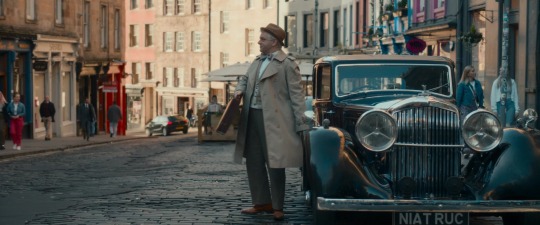
This is the beginning of a series of posts focusing on Aziraphale's trip to Edinburgh in S2. Several times people have asked why he even had to make the trip - why didn't he just email the pub to ask his questions? Ah, thinking like true child of the 21st century, you are! In a narrative sense, its not that simple, especially in the GO narrative where there are always parallels to be found to enhance the story. And I think there a couple of other reasons why its been hard to understand the reason for this drawn-out and apparently dead-end investigation, which haven't really been explored or talked about much yet. We will start to look at one of them in this meta.
I mentioned a while ago when I was putting together the S2 Chiastic structure that I was hoping to find some hints to the purpose of the trip to Edinburgh. What it did reveal was that the trip was a larger parallel to Crowley's trip to Heaven with Muriel in S206. This is pair S; where the publican in the Resurrectionist asks Aziraphale if he one those investigative reporters in S203, matched with Crowley bounding up to Muriel at the end of S2E5 and declaring "Officer, I need to report a crime."
Both Crowley and Aziraphale have fantasy alternative personas. Most of us are familiar with Crowley's James Bond role-playing from time to time and other hints of tough masc characters he sees in films.
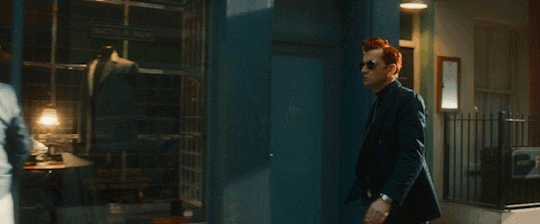
When he dons the "tactical turtleneck" we know there is some kind of super-spy power cosplay going on (and it also extends to other characters, such as Gabriel and Saraqael, if you pay close attention.) Hence why it's part of his costume when he infiltrates Heaven.

But we don't often see this wishful side of Aziraphale's, other than his dream of being a magician. According to Neil, he also sees himself as a journalist, a detective and a "man of the world." *
The publican asks Aziraphale if he is one of those "investigative reporters" when he arrives at the Resurrectionist, and sometimes that is the dual role of a journalist, to be both a detective and a reporter.
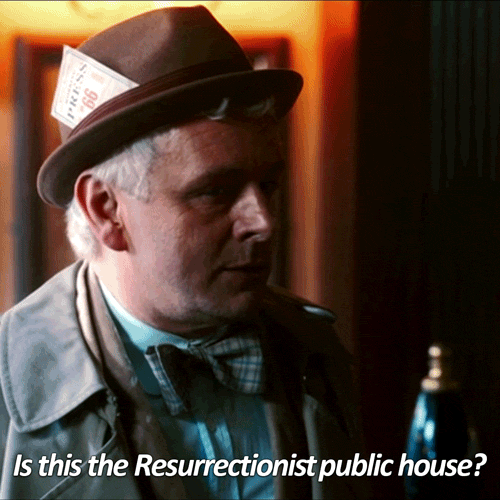
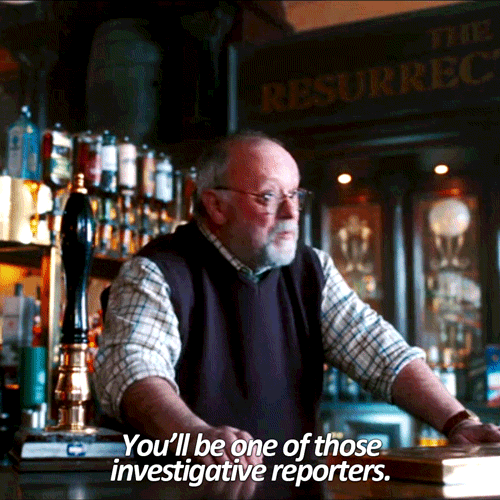
Crowley has gone upstairs to gain access Gabriel's record, the one place he can do that.

Aziraphale also gets hold of Gabriel's record...er, recorded song.
Hang on, no. That's not right way to look at it, actually.
While you might think the focus is still on finding out about Gabriel in Edinburgh, Aziraphale's mirror in S2 is Beelzebub, so there is a slight twist in the way we need to consider various aspects here.
Perhaps this should be "Aziraphale gets a hold of Beelzebub's music" instead, because he's really going to Edinburgh to find out more about Beelzebub, he just doesn't realize it.
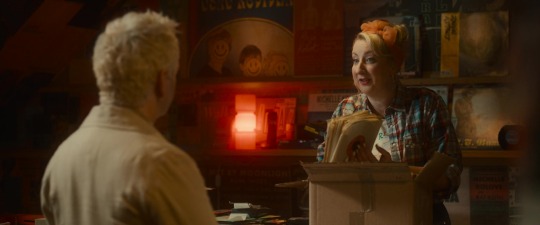
Yep, you heard me right. The trip to Edinburgh is not a fact-finding mission about Gabriel, its actually a fact-finding mission about Beelzebub. And he doesn't get the answers he needs.
Neither does Crowley, by the way.

GABRIEL: I told you you could ask. However, I am the only First-Order archangel in the room, or, you know, the Universe, so I'm not gonna answer so much. But you feel free to knock yourself out with all the asking. Anyway, Armageddon the Sequel, that's a nah.
Crowley wonders out aloud why Gabriel changed his mind about starting another Armageddon, but the trial doesn't really answer that either. Nothing is really answered until Gabriel regains his memories, in the end.
To round out this post about the parallel investigations, each of them take an opposite with them, that they couldn't have got there without: Crowley takes an angel (Muriel) and Aziraphale takes a demon. Well, something demonic, anyway. **
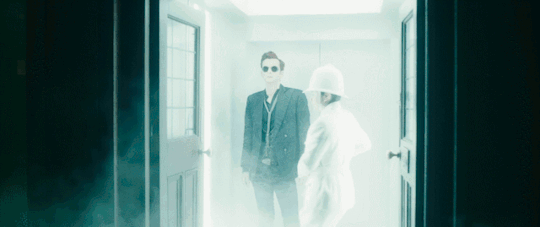

Thank you to @komorezuki for pointing out that the trip to Edinburgh was really about Beelzebub. While you could still do this post making it a full Gabriel parallel, in the long run it makes more sense to look at the other way, as I hope to show you in the forthcoming posts.
*I thought I had a link to the post that this came from, then lost it. I've spent several hours trying to find it again with no luck, so if you know the post I'm referring to please let me know so I can link it!
**I've read that Aziraphale could have taken the train in less time it would have taken to drive, and that the train station is only a short walk from the pub etc. But this wouldn't have driven the narrative!
This series continues in the following posts:
Part 2: Aziraphale-Beelzebub Parallels Part 3: Stocktaking in the Basement Part 4: Judgement Day Part 5: I Know Where I'm Going
#good omens#good omens 2#good omens meta#crowley#aziraphale#gabriel#beelzebub#edinburgh#chiastic structure#tactical turtleneck
55 notes
·
View notes
Text
I really like what you've got here and a lot of it scans for me! The connection between records (in multiple senses) and forgiveness in the chiastic structure makes a lot of sense, as does the idea of stealing files from heaven in the first place.
Now, you don't quite come out and say it, but I think you're saying that the object that is exchanged in the kiss is Gabriel's fly, right? If I'm misinterpreting that, then disregard the rest. If that is what you're saying, then I have more questions:
How is it possible to keep a fly in one's mouth? Beez is made of flies, so it's a bit different for them. Neither Crowley nor Aziraphale are made of flies, so I would think a fly would buzz wildly around their mouths? Maybe the fly is just special and doesn't buzz or fly in certain situations.
We don't see the fly leave Gabriel's eye, do we? I guess if I'd thought about it, which I did not before this moment, I would have assumed the fly was absorbed into him. And the records he stole from heaven that are not his memories would be absorbed into him, too, in that scenario.
When/how does Crowley get the fly to give it to Aziraphale? Unless we have a time stoppage situation.
So, in sum, I think you're very close to cracking the case. But what if we have two heavenly record thefts: one by Gabriel (and those records are now part of his memory because he absorbed the fly) and one by Crowley the preceding night? And Crowley puts those records into some receptacle (not a fly) and gives them to Aziraphale? Although the question of when this happens is still outstanding.
The Big Damn Kiss
Buckle up, my fellow Good Omens Ineffable Mystery Puzzlers, Crackpotters, and Assorted Brainrotters, because I learned something HUGE yesterday.
This will be a bit of a long post, because I want to show you exactly how I got where I am. I want you to understand. I want to put all the naysayers to bed (ha! But I'm still gonna try), and settle this once and for all.
I know (almost) exactly what Crowley gave to Aziraphale during the kiss.
DO NOT TAKE ANY OF MY THEORIES TO NEIL! PLEASE!
Okay? Okay. Thanks. Shall we begin?
Ahem.
Firstly, whether you believe me or not, I am 100% certain that Crowley did, indeed, give something to Aziraphale in his mouth during The Kiss. I've covered that in the link previous. Okay? Okay.
I did not know what it was. I've now heard theories that it was a bullet (nope), a ball bearing (nope), hellfire (nope), and no one, NO ONE has suggested what I see. (If you have, hello! Talk to me!)
Here's our first foreshadowing Clue:
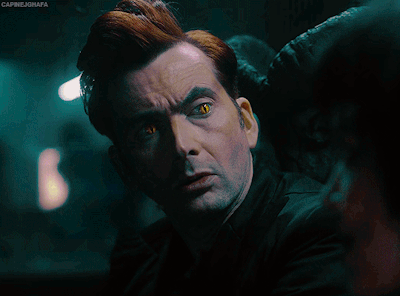
And here's our next foreshadowing Clue:
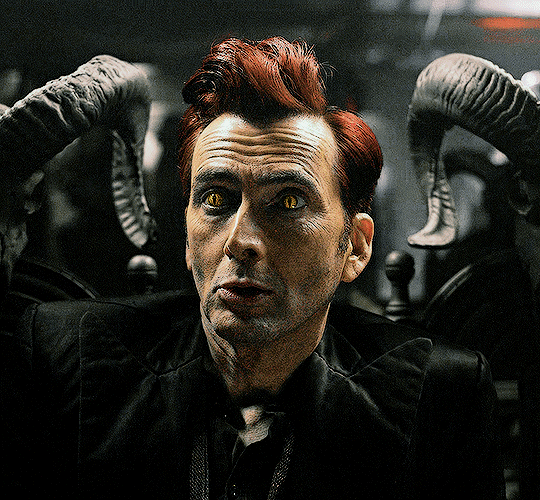
And the next:
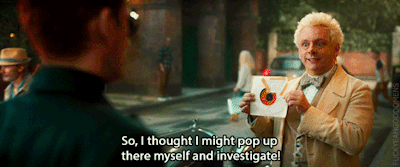
And our last Clue:
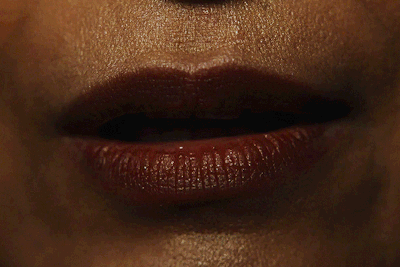
With me so far? Well, that first GIF is a bit off, I couldn't find one of Crowley actually spitting out the flies. But he does. When Beelzebub first drags him to Hell, he actually goes "Pleaugh!" and spits out four or five flies.
Moving right along, we come to Crowley in Heaven with Muriel, looking at the trial. We learn two important things here:
One, Gabriel doesn't have a desk.
Two, Muriel does. Where they keep the records. And it's a bit lonely. Every few hundred years, someone comes and asks for something. Muriel can't access the sensitive ones, you have to be pretty high up. A throne, dominion, or higher. Like, maybe Supreme Archangel?

So if Gabriel doesn't have a desk, whose desk is he at when he's getting ready to leave Heaven? Of course I can't find a damn picture of Gabriel at the desk, but it's Muriel's. Where they keep the RECORDS.
Gabriel puts his memory into the fly, then gets on the elevator to go to Earth.
Now, when Gabriel opens the fly with his memories inside, we find out that it's a container. Bigger on the inside. You can put thing(S) in it. The bit we see of him remembering is shot in two parts, one where he's flying down a red tunnel, one where he's flying down a blue. If you slow this scene down and watch, you can see that he is NOT looking at just his own memories. There is more going on here, more that he was not present for. @embracing-the-ineffable put up a great meta about that here. Go look!
Now I figured Gabriel must have taken something else. Something important. Something useful. Something he meant to give to Aziraphale, except he forgot.
I also figured he must have left whatever it was in the fly when he took his memories out.
But I had no idea what Gabriel took until I started working on the chiastic structure of season 2. I'm not done with that analysis yet, but let me show you one thing that I have found so far:
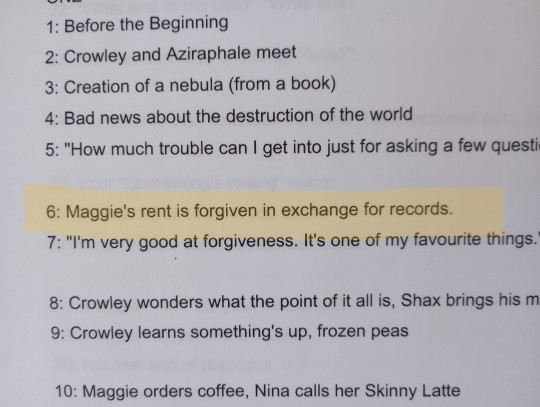
(The numbers are just to try and help me navigate the story and its events without time stamps)
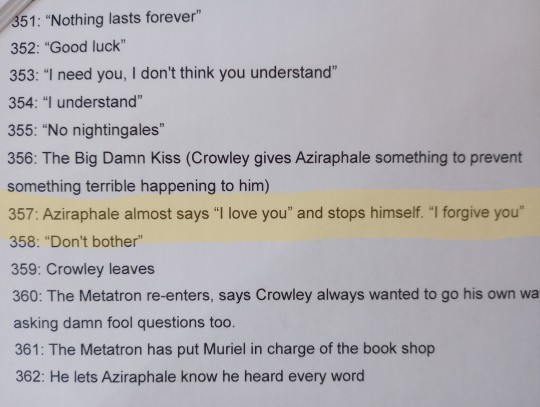
My note #357 of what happens isn't quite right, but when I saw the only two times Aziraphale says "I forgive you" are towards the beginning of Season 2 and towards the end, I realized I had something.
Rephrase line 357: Crowley's kiss is forgiven IN EXCHANGE FOR RECORDS.
(Not that I think Crowley's kiss needs to be forgiven. It's just what Aziraphale says, and had to say at that moment, because the Metatron was listening in.)
What does Heaven in Good Omens remind us of most of all?
A big corporate entity. And what do powerful people do when they get fired from a big corporate entity? They download all their emails while they're cleaning out their desks. Damning emails. Emails that can be used to black mail or even destroy big corporate entities. Or, ya know, maybe they swipe some sensitive RECORDS?
Oh yes.
Here's Aziraphale reading the records:
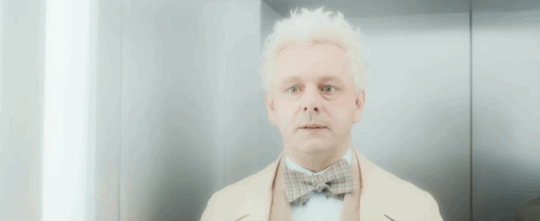
Here's Aziraphale being horrified and outraged by what he's reading:
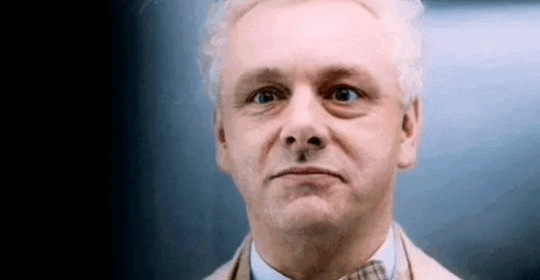
And here's Aziraphale realizing he has got some GOOD DIRT on Heaven. Maybe enough to bring them down:

That's it folks. I have no idea what the records actually say, and maybe we're not meant to know until season 3, but whatever it is, it's GOOD.
That's my story, and by God Herself, I'm sticking to it.
#i feel absolutely insane typing this out#i think we're on to something but it sounds batshit#good omens meta#good omens theories#good omens clues#ineffable mystery#ineffable discontinuity#don't ask neil#don't tag neil
397 notes
·
View notes
Text
The Strength of a Symmetrical Plot
One of my favorite studies of Harry Potter is that of the ring composition found both in the individual novels and overall composition. That very composition is what makes Harry Potter such a satisfying story. It’s a large part of the reason Harry Potter is destined to become a classic.
And it’s an integral part of the series many people are completely unaware of.
So what is ring composition?
It’s a well-worn, beautiful, and (frankly) very satisfying way of structuring a story. John Granger, known online as The Hogwarts Professor, has written extensively on it.
Ring Composition is also known as “chiastic structure.” Basically, it’s when writing is structured symmetrically, mirroring itself: ABBA or ABCBA.
Poems can be structured this way. Sentences can be structured this way. (Ask not what your country can do for you — ask what you can do for your country.) Stories of any length and of any form can be structured this way.
In a novel, the basic structure depends on three key scenes: the catalyst, the crux, and the closing.
The catalyst sets the story into the motion.
The crux is the moment when everything changes. (It is not the climax).
The closing, is both the result of the crux and a return to the catalyst.
In Harry Potter, you might recognise this structure:
Voldemort casts a killing curse on Harry and doesn’t die.
Voldemort attempts to come back to power
Voldemort comes back to power.
Harry learns what it will take to remove Voldemort from power.
Voldemort casts a killing curse on Harry and dies.
But all stories should have this structure. A book’s ending should always reference its beginning. It should always be the result of some major turning point along the way. Otherwise, it simply wouldn’t be a very good story.
What’s most satisfying about chiastic structure is not the basic ABA structure, but the mirroring that happens in between these three major story points.
To illustrate what a more complicated ABCDEFGFEDCBA structure looks like, (but not as complicated as Harry Potter’s, which you can see here and here) Susan Raab has put together a fantastic visual of ring composition in Beauty and the Beast (1991), a movie which most agree is almost perfectly structured.
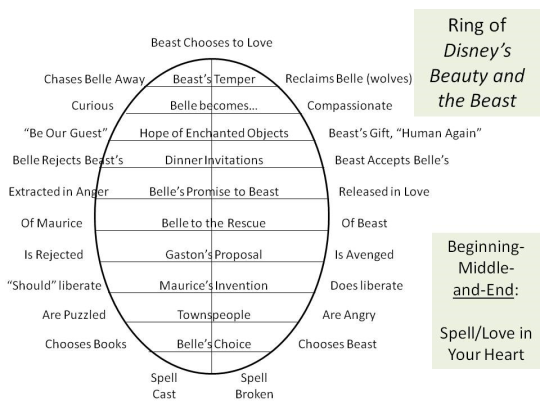
source: x
What’s so wonderful about ring composition in this story is that it so clearly illustrates how that one crucial decision of Beast changes everything in the world of the story. Everything from the first half of the story comes back in the second half, effected by Beast’s decision. This gives every plot point more weight because it ties them all to the larger story arc. What’s more, because it’s so self-referential, everything feels tidy and complete. Because everything has some level of importance, the world feels more fully realized and fleshed out. No small detail is left unexplored.
How great would Beauty and the Beast be if Gaston hadn’t proposed to Belle in the opening, but was introduced later on as a hunter who simply wanted to kill a big monster? Or if, after the magnificent opening song, the townspeople had nothing to do with the rest of the movie? Or if Maurice’s invention had never been mentioned again after he left the castle?
Humans are nostalgic beings. We love returning to old things. We don’t want the things we love to be forgotten.
This is true of readers, too.
We love seeing story elements return to us. We love to know that no matter how the story is progressing, those events that occurred as we were falling in love with it are still as important to the story itself as they are to us. There is something inside us all that delights in seeing Harry leave Privet Dr. the same way he got there–in the sidecar of Hagrid’s motorbike. There’s a power to it that would make any other exit from Privet Dr. lesser.
On a less poetic note, readers don’t like to feel as though they’ve wasted their time reading about something, investing in something, that doesn’t feel very important to the story. If Gaston proposed to Belle in Act 1 and did nothing in Act 3, readers might ask “Why was he even in the movie then? Why couldn’t we have spent more time talking about x instead?” Many people do ask similar questions of plot points and characters that are important in one half of a movie or book, but don’t feature in the rest of it.
Now, ring composition is odiously difficult to write, but even if you can’t make your story a perfect mirror of itself, don’t let story elements leave quietly. Let things echo where you can–small moments, big moments, decisions, characters, places, jokes.
It’s the simplest way of building a story structure that will satisfy its readers.
If there’s no place for something to echo, if an element drops out of the story half-way through, or appears in the last act, and you simply can’t see any other way around it, you may want to ask yourself if it’s truly important enough to earn its place in your story.
Further reading:
If you’d like to learn more about ring theory, I’d recommend listening to the Mugglenet Academia episode on it: x
You can also read more about symmetry in HP here: x
And more about ring structure in Lolita and Star Wars here: x and x
And about why story endings and beginnings should be linked here: x
#ring composition#structure#novel writing#creative writing#mine#writing tip#writing tips#novel writing tips#creative writing tips#writing advice#novel writing advice
16K notes
·
View notes
Photo

Proverbs 31: An Impossible Standard Contributors Talbot School of Theology at Biola University Nell Sunukjian Many women, and men, too, avoid studying Proverbs 31:10-31 because they think it presents an unrealistic and unattainable standard for women. I can’t tell you how many articles I have read that describe this lady as ‘superwoman’ and, therefore, not applicable for the average female But would God really put a job description in His Word if it were unattainable? Surely our knowledge of Him says the description of the woman of noble character was placed in the Scriptures to encourage us, male and female. It’s for our edification; there is much we can learn from it about becoming wise women. Proverbs is a textbook on wise living. The phrase “the fear of the Lord is the beginning of wisdom” is found 14 times in Proverbs and notably, the book closes with a flesh-and-blood example of one whose whole life has been given to the pursuit of wisdom—the Proverbs 31 woman. She demonstrates in daily life that wisdom is not an esoteric idea dispensed to learners; it is living in wise ways, living in harmony with God’s creation and His laws. Wisdom is right living, good decisions, and honorable choices. The poem opens with the idea that a wise woman—one who fears the Lord—is valuable, though quite rare. And she is worth the search! For when found, she will be of the highest personal character and fiscally responsible. She is described in verse 10 as being of “noble character” and “worth far more than rubies.” Verses 11-12 speak of her financial savvy. Her husband has “full confidence” in her and “lacks nothing of value.” Those are monetary words. And so are these: “she brings him good, not harm.” She not only guards the family assets; she also brings in a significant amount of income. She’s a moneymaker! The first major section of the poem, verses 13-19, delineates how hard this woman works to provide for her family and to earn income. It’s arranged in a chiastic structure, with ideas leading up to the main idea and then backing away with parallel ideas. Kinda like the way my sister and I communicate. If you hear us talking, you may be confused—#Christianposts #sbs https://www.instagram.com/p/Bxy6kC9jQ0p/?igshid=g681s98tz8kw
0 notes